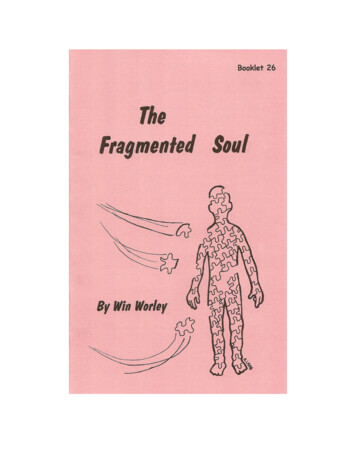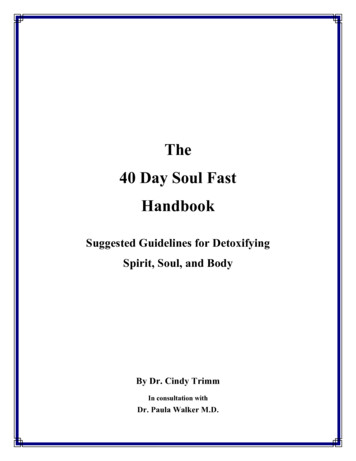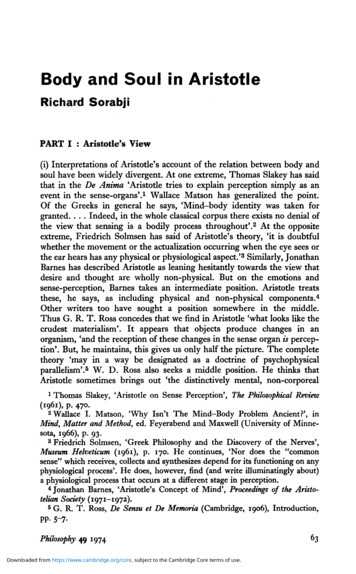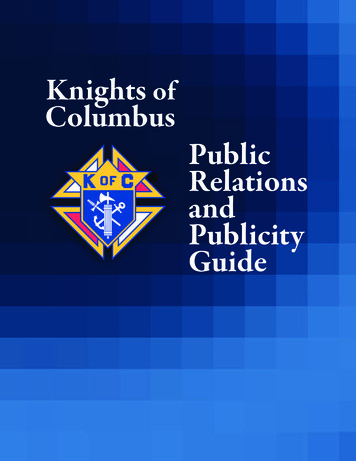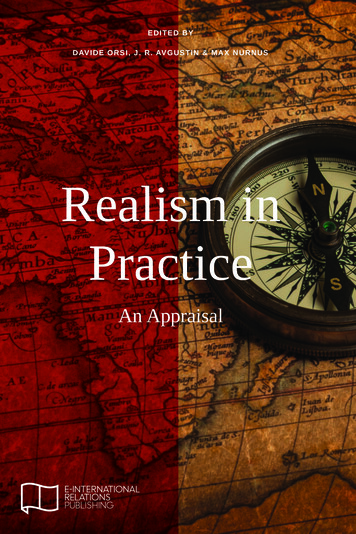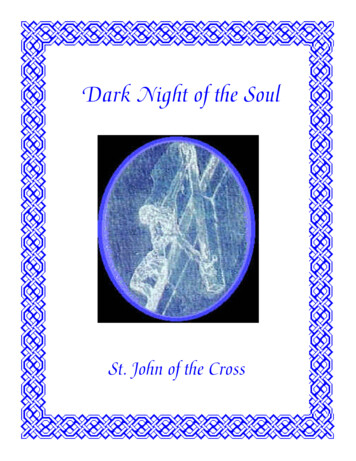
Transcription
On the Relations of Soul to Bodyin Plato and AristotleTHOMAS M. OLSHEWSKYMY CONCERN IN THIS PAVER is to give an exposition of, apology for, and to drawimplications from, the following contrastive statement:On Plato's understanding, the soul is in the body; but Aristotle's accountimplies that the body is in the soul.On first glance, the former clause seems commonplace and quite intelligible, whilethe latter seems to do violence both to history and to common sense. One can perhapsunderstand how a soul could be in a body, on analogy to a loaf of bread in a breadbox,or to a pilot in a ship--or even to a ghost in a machine; but a reversal of the relation ofbody and soul seems as ludicrous as a reversal of these analogue relations of containment and of agency. Yet, I hope to show that Plato's account is an unintelligible one,especially in the light of his own ontology; that while Aristotle never asserted the relationship that I claim for him, his account of body and soul clearly requires it; thatAristotle's account is both consistent with his own ontology and intelligible in its ownright.I.The first clause of the aphorism is prima facie unproblematic, the characterization in the Phaedo of the body as the prison house of the soul being a commonplace.How we are to understand the soul/body distinction in Plato, together with this container model for their relationship, is not all that clear. Indeed, we find shifting concerns,if not shifting concepts, through the several dialogues. Crombie has astutely delineatedthree different contexts in which the soul/body distinction is of concern: (1) the religious context, in which the concern is with the soul surviving the body after death;(2) the psychological context in which a distinction is drawn between the psychologicaland the physiological, and their interaction considered; (3) the ethical context, in whichconcerns with spiritual needs and activities are distinguished from concerns with carnalneeds and activities. 2 That there are conceptual shifts from context to context canreadily be argued; that one context will frequently be coalesced or confused with anotherseems patent; that all three contexts of concern with the relation of body to soul exist1 An early version of this paper was presented under the title "Conceptions of Psyche inPlato and Aristotle" to the Southern Society for Philosophy and Psychology in 1972. My thanksfor subsequent criticisms by David Hamlyn and Henry Schankula, making it impossible for thisto be that version. I must also thank T. M. Robinson, Jesse deBoer, Hippo Apostle, and AlanPerreiah for their comments on a later version. I have cited quotations from Plato and Aristotleby the standard texts, using a variety of translations, some my own, and noting Greek termswhere interpretation might be questionable.I. M. Crombie, An Examination of Plato's Doctrines (London, 1963), I, 293ff.[391]
392HISTORY OF PHILOSOPHYin Plato's dialogues is evident. The first problem we face is to find some coherent concept or set of concepts of psych which will give adequate understanding for the relationof the soul to the body, while acknowledging the various concerns involved.The concerns that dominate in the Phaedo are the religious and the ethical ones. Theconception of the soul is unitary in characterization and discrete from the conception ofthe body. By Book IV of the Republic we have a tripartite characterization of the soulwith an accent on at least functional integration with the body. Here, psychological concerns dominate in an ostensively ethical context--an ethical context, however, in whicha soul/body distinction is not accented, but where moral defects are rather accountedfor in terms of disfunctional relationships within the soul. This requires Plato to fudgea bit in the latter part of the Republic, maintaining that only a portion of the soul survives the body. 3 We can perhaps see in the mythical account of the Phaedrus an attemptto reconcile these several concerns, with the surprising result that divine souls as wellas human ones have a tripartite composition of rational, passionate and appetitiveelements, only more reliably in harmony on the ideal model. In the Phaedrus, the tripartite conception is treated as appropriate to the soul's ideal nature, while in theRepublic and the Tirnaeus, the composite nature is treated as derivative from theresponsibilities necessitated by the soul's earthly charge of occupying a body. There isno clear indication which view is finally to be attributed to Plato.For religious concerns, the soul is conceived as substantial, personal and separable.As substantial, it is a stuff or entity distinguishable from the body; as personal, it hasindividual characteristics that distinguish it from the souls of others; as separable, it isnot dependent upon the body for its existence (this last, of course, is a point argued forthroughout the Phaedo). Early in the dialogue, Socrates characterizes the soul as rational, and suggests that the hearing, sight, pleasure and pain of the body are impedimentsto its function (65C5-7). While there are suggestions of cognitive pleasures as well asbodily ones (e.g., 65A7, 65C9), the soul is so closely identified with intellection thatthis latter term (dianoia) is sometimes substituted for the former. This characterizationof the soul presents particular problems for Plato's account of personal immortality: Ifthe soul is closely identified with the rational, then in what sense are individual differences, and thus personality, maintained in the survival of the soul from the body? Ifthe soul is not so identified, then in what sense is the soul so separate and distinct fromthe body? The notions of recollection and of ideal forms as the only true objects of intellection do not alleviate this problem; they only accentuate it. And it remains a problem not only in this dialogue, but for Plato's conception of immortality throughout hiscareer.Perhaps more to the point of my concerns is the container model exhibited in thenotion that the body is a prison house (82E2, 92A1). This model demands, ironically,that we treat the soul in spacialistic-physicalistic language. If the bread is to be containedby the breadbox, then it must have dimensionality and distribution in space; it occupies space as well as place. So too for the soul if it occupies a body. This invites ourtreating the soul on analogy to the body, as being "healthy" or "ill," as being "draggedby the body" (79C5), as having "pleasure," as itself being a container for its contents.It also invites the notion of the soul becoming contaminated by its occupancy of thebody (e.g., 81B, 84A8ff.), just as the bread might be contaminated by the moisture or3 For an argument against this interpretation, cf. T. M. Robinson, Plato's Psychology (Toronto, 1970), pp. 50-54.
PLATO AND ARISTOTLE393bacteria in the breadbox. Indeed, in the myths of afterlife, both in the Phaedo and inRepublic X, the souls are seen as having all of the bodily characteristics that presum-ably are to be left behind at death. Nothing in Plato's conceptual equipment helps us to9 shuck the chaff of the mythical motifs for an adequate non-physical model.In contrasting the soul to the body, the container model proves an ineffective instrument. Plato does give some initial contrastive characterization in the Phaedo, calling thesoul "invisible, divine, immortal, and wise" (81A3), but here, "divine" and "wise"seem little more than epithets, and immortality is what remains to be argued for. Invisibility offers little more than a negative contrast. Indeed, whenever souls require somecharacterization as individuals, they must be "fleshed out" with bodily characteristics,as the container model invites. It seems that it is the permeation of the soul by thecorporeal that gives it not only its impurity, but its personality as well. Talk of thesoul's magnitude (Republic 431A7-B1, Laws 689A9) and its reception of sensation(Theaetetus 184ff., Philebus 33D2-E1) accentuates this problem in later dialogues.In relating the soul to the body, the container model also proves ineffective. In thePhaedo, the relation seems dependent upon the body's infecting the soul. The tripartiteaccount in the Republic attempts a more viable view by incorporating in the soul partsthat were earlier attributed to the body. While this may give a better account of thefunctioning of the person, it does not itself advance any positive account of the soul'srelation to the body. In the Timaeus these parts are seen as distributed to the head,heart, and belly (69D6ff.), and more diffusely throughout the bone structure. The soulis fastened to and contained in the marrow, which is especially constructed as the innercontainer for the soul (73C). While this further localizes the soul within the body structure, it fails to give any account of their relation or interaction. Indeed, it further invites a physicalistic-materialistic account of a refined container model. While Platoopposes throughout the atomistic alternative for an account of the soul's relation to thebody, his container model diives him closer to it with each refinement. On the basis ofthe container model, he seems required either to give a physicalistic account of the relation, or to give no account at all.The treatment of life as the logos of soul is a traditional view that Plato dearly presupposes in at least two of his arguments for immortality in the Phaedo (69E-72D,102Aft.). In the latter argument it becomes a tour de ]orce once certain concessionsabout the forms are made, but it yields no particular insight into the relation of the soulto the body. The soul brings life to the body, but there seems to be no claim that as aresult the soul brings the body to life. Life is the logos (or at least the defining characteristic) of psych , and psych is separate and distinct from soma. If we identify the selfwith soul (as Plato frequently does), then a person never dies; if we identify the personwith soul and body (as Plato sometimes does), then the person is alive when his bodyand soul are together and dead when they are separated. The latter seems to be the viewof the first argument in the Phaedo; the former the view of the last argument. That bothfail to give much of an understanding to the difference between fife and death rests uponneither view's giving any consideration to the way in which soul is related to body.The similarity of the soul to the forms, suggested in the Phaedo and expounded in theTimaeus, may give some hope of accounting for the way in which the soul is in thebody. "On the one hand we have that which is divine, immortal, indestructible, of asingle shape [morphg], accessible to thought, ever constant and abiding true to itself;and the soul is very like it; on the other hand we have that which is human, mortal,destructible, of many shapes, inaccessible to thought, never constant nor abiding true
394HISTORY OF PHILOSOPHYto itself; and the body is very like that" (80B1-5). While the comparison is suggestive,it is not very helpful. Some maintain that later in the dialogue Plato treats the soul as aform (eidos).* But even if this were so, he never treats it as the form of the body. Also,the plurality of souls would preclude treating the soul as form in any univocal sense,since actually to be forms, their plurality requires a different nature for each. Further,Plato would not say that the body "participates" in the soul as other physical objectsare said to participate in the forms in the middle dialogues; nor that the body is a composite of the soul (sic) as the objects are suggested to be composites of forms in the laterdialogues. Objects are never said to contain forms in the way that the body is said tocontain the soul. Whatever satisfactions the analogy of form/soul as object/body maygive, it gives no credence to the container or any other model for the relation of soul tobody.The analogy does generate dissatisfactions with the role of souls as such in Plato'sontology. Souls are neither of the realm of forms, and being, nor of the realm of physicalobjects, and becoming. They exhibit properties of the former (unity, identity, etemality),but also properties of the latter (plurality, position, corruptability). Plato speaks to thisproblem in the Timaeus, locating the world soul (and by imitation, individual souls) inan intermediate state between being and becoming. Following Cornford's interpretationof 35Aft., 5 we find the demiurge first combining the indivisible with the divisible ofexistence, sameness, and difference; then combining those mixtures together to get soul:FIRST/VIJ.XTUREIndivisible existenceDivisible existenceIndivisible samenessDivisible samenessIndivisible differenceDivisible difference1SECOND/VJ.I.XTUREIntermediate existenceIntermediate samenessSoulIntermediate differenceThese forms are three of the five "greatest kinds" set forth in the Sophist. B They arewholly distinct and all-pervading. By the combination of the divisible with the indivisible, the intermediate status of the soul becomes both generated and intelligible; everlasting, but in time. Although like the forms as described in the Phaedo, it requires thechange of the realm of becoming to be both alive and intelligent. It functions throughtime in space, where the forms themselves cannot go, but it knows the forms as likeknows like, since it is composed of those forms that pervade all forms.This account of the composition of soul is unworkable both in relation to the realmof forms and in relation to the realm of physical things. The soul is clearly neither aform, nor a combination of forms; it is neither a physical thing, nor a combination ofphysical things. That it is intermediate gives some satisfaction to Plato's earlier char4 E.g., Gregory Vlastos, "Postscript to the Third Man: A Reply to Mr. Geach," PhilosophicalReview, LXV (1956), 93, n. 14.n F. M. Cornford, Plato's Cosmology (London, 1937), pp. 59-66.o The relative dates of the Timaeus and the Sophist are important to Cornford's interpretations, but not to my discussion here. For a recapitulation of the controversy, cf. Robinson, pp.70ft. It is important to note that motion and rest, which lack the pervasive and distinct nature ofbeing, same and different, would provide an account of motion that is lacking in this part of theTimaeus and is given over to necessity in later parts.
PLATO AND ARISTOTLE395acterizations, and seems to be required by his epistemology. How it is intermediate canfind no consistent answer in his ontology. If the forms cannot mix with the physicalrealm, then the indivisible cannot mix with the divisible, and the basis for the intermediate is undercut. If the forms can mix with the physical, then the need for the intermediate is undercut. Either way, this account of the soul fails to be workable.On Timaeus's account, being (rv), space (XcbQav), and generations (y veotv) are thegivens of the universe (52D4) with which and upon which the demiurge imposes theorder of reason (voa3g) upon the world, against the constraints of necessity (&v y The being here is evidently the forms; the space, more than just extension and place,is a medium for receiving shapes (morph ); the generations are erratic happenings, byvirtue of the shaking of the medium by its given constraints (ananke). This last is evidently to serve as the account of how it is that necessity causes motion (48A8). Thatwhich reason contributes is not the motion itself, but its ordering, through the creationof time. It is against this backdrop that the creation of soul must fit.The mixing of intermediate existence, sameness and difference is described in termsof complicated due proportionality which involves not only number but magnitude. Thistakes place without reference to the medium of space or to the constraints of necessity.The result is a soul which is rationally harmonious, and thus equipped to know, but notrelated cosmogenetically with the limitations of the world in which it is to operate. Whenthe creator sees that the world soul is alive and in motion, he wonders (r(37C8). 7 If the life and motion are part of the soul's nature, they are implausiblyabsent from the soul's design, and cannot be accounted for in terms of it. The designaccounts only for its noetic character. Indeed, since the ground of all motion is attributed to the generations of space in this dialogue, and since no relation to space isestab/ished in the generation of the soul, the attribute of motion in the soul seemssingularly anomalous.The characterization of the ingredients of the soul as intermediate between the indivisible and the divisible can only be metaphorical in the light of the order of creation.The plurality of the body of the world is the result of the limits imposed by necessityupon reasoned order. These limits are not imposed upon the soul because (1) the composition of the soul involves no accounting for necessity and (2) the creation of the soulprecedes the creation of the body. Cosmologically, the plurality of souls is not a necessity, but the outpouring of divine delight, a strange result in the light of the higher valueof unity.The container model continues to impose physiealistic terminology on talk about thesoul. The world soul not only permeates the world body, but it also envelops it (36D6ff.).Again, the basis for contrast is that the body is visible, the soul is not; the soul is intelligent, the body is not (37Altt.). But again, these contrasts provide no insight intothe body/soul relation, nor any rationale or excuse for the container model with itsphysicalistic terms. Here, as elsewhere, the container model fails to illuminate the body/soul relation and finds no connection to the characterizations given for the body and forthe soul. The treatment of magnitudes of soul-stuff in the composition of the world souland of quantities of soul-stuff in the distribution of the human soul through the humanbody only compound the puzzles and problems.7 The more usual translation treats the demiurge as rejoicing. However we translate "rhere, there is no evidence that the demiurge anticipated life and motion, much less planned forit; nor is there any suggestion of why motion and life should come into being by virtue of thecomposition.
396HISTORY OF PHILOSOPHYMotion in the Timaeus is grounded in the generations of space by necessity, and inheterogeneity (57E). Only for rational motion does the soul play a part. In the Sophistmotion and rest are introduced among the greatest kinds to explain motion. But in thePhaedrus the very logos of psych is "that which is activated by itself" (245E3). This isechoed in the Laws Bk. X, where the Athenian declares that "the logos for the thing ofwhich 'psych " is the name" is "the motion which can set itself moving" (896A). Here,the static accounts of soul in the Phaedo and the mechanistic accounts of motion in theTimaeus seem to be abandoned for a more fundamentally teleological conception of theuniverse. This later view of the soul at once gives expression to a popular conceptionand lays the basis for a metaphysics of motion. Kinesis must have some origin. Thearch of motion by those entities that do not move themselves must be in things that areself-moved. Such self-activating beings are souls by definition, and the ultimate sourceof all motion.Here, we have shifted from a container/contents model to an instrument/agent modelfor the relation of body to soul. If the soul is the source of motion, then bodies aredependent upon souls for any movement. In this sense, the soul has care of all that isinanimate (Phaedrus 246B6-7). In the Laws Plato strikes the same note in treating ofthe soul-stuff of the universe: The primary motions of the soul bring secondary andcorporeal movements into being (897A). Here, the primary movements are describedas instruments of the soul (897B1) to effect through secondary movements (a secondary instrumentality) all that is affected in the universe.The first thing to note about this conceptual shift is that it does not provide, asclaimed in both the Phaedrus and the Laws, a logos for the soul. The soul provides anaccounting for motion, not the other way around. This leaves the soul in the esotericposition of being unaccounted for. Like the unmoved mover of Aristotle and the uncaused cause of Thomas, Plato's self-moving movers are mysteries beyond the pale ofexplanation. If this is what "divine" as an epithet for soul is to convey, it seems appropriate to a religious context of mystery and worship. In a philosophical context ofexplanation and inquiry, it becomes no more than a deus ex machina to treat an important matter never adequately handled in the theory of the forms.The second thing to note is that this claims a kind of relation between soul and bodymore clearly than the container model seemed to allow, but it provides us with nounderstanding of how that relationship obtains. Primary motions are said to be: "Wish,reflection, foresight, counsel, judgment, true or false, pleasure, pain, hope, fear, hate,l o v e . . , and whatever other k i n d r e d . . , motions there may be" (897A1-3). These aresaid to "bring in their train" increase and decrease, integration and disintegration, andall their attendant characteristics in corporeal movements. Even if we avoid extendingPlato's affinities of kinds to "like causes like" here, we are left with no clue of howmotions of the first sort are to cause motions of the second. The best that he can musteris a reiteration that the circular motions of the planets emulate reason (898B). We areleft again with the assertion that the soul is the caretaker of the body (now in a morepositive light than with the container model), but with no account of how the one isrelated to the other.Finally, it is important to note that the image of a sailor in a ship does not adequatelyexpress the agency model, at least not as it is expressed in the Laws. A sailor directs aship, but the power for the motion of the ship comes from the wind, not from the sailor.Also, the sailor is contained in the ship (a hangover from the container model), and is
PLATO AND ARISTOTLE397thus conveyed through space by it. In comparing possible relations of the sun's soul toits body to the human soul/body relation, Plato treats the human soul as containedwithin the body, but the body as conveyed by the soul (898E8). Since the source ofmotion as well as direction is attributed to the soul, we have as a result a containernotion of the body and a conveyer notion of the soul, which seems to defy any imagingtechniques that we can muster for our modeling.I have not here attempted to give a survey of Plato's psychology,s Many conceptions(e.g., the ethical import of the relation of parts) and problems (e.g., the relation of thenoetic-soul concept to that of the life-soul) I have left untouched. My concerns havebeen to show: how Plato's conception of the soul as in the body relies upon thecontainer/contents model and (at least in the Phaedrus and the Laws X) upon theinstrument/agent model; that these models, at least in Plato's hands, provide no adequate basis for the relation of the soul to the body; and that Plato never really finds aplace for the soul in his ontology (unless we read Laws X as a new ontology completelydisplacing the theory of forms). The container model requires modeling the soul as asubstance analogous to body, and allowing their relation only by undercutting theirdistinction, and that by understanding soul in terms of body. The agency model maysustain the distinction, but it leaves the soul as an esoteric non-physical entity, doing"this work of guidance by some other most miraculous faculties of hers" (Laws 899A).The formula of the soul in the body, on either model, proves inadequate for maintaininga body/soul distinction, for relating the body to the soul, and for locating the soul within the conception of the world.II.Having shown the implausibility of the more familiar formula, at least in Plato'streatment of it, the task remains to elucidate the unfamiliar one in the fight of Aristotle'swork. This task is made difficult by its being a formulation as foreign to Aristotle'sdiscourse as to our own, and by certain unresolved conceptual problems in Aristotle'streatment of form. The resolution of the former difficulties can be found, I think, in theresolution of the latter.In On the Soul Aristotle concludes his discussion of the definition of the soul (N.B.:not two definitions) with: "Soul is an actuality or formulable essence of something thatpossesses a potentiality of being besouled" (414a27). In the course of coming to thisconclusion, he treats soul (ap X l) as an instance of form (e' o ) and of actuality( v e? eta), and in parallel fashion he treats body (o 5 ta) as an instance of matter({ 1) and of potentiality (Sa%a ttg). He also speaks of the soul as in ( v) the body, butdenies that this sheds any light on the analogy of body/soul to ship/sailor (413a8). InOn the Soul, as in the Metaphysics, he tends to treat "form" as equivalent to "shape"( toQq) l). In the Metaphysics he tends to use " v Qyrta" and " we .g;(ta" as roughlysynonymous (though he does note a difference in range of meaning between them,1047a30): but in On the Soul, these terms no longer appear in conjunction, nor are theyinterchangeable in discourse. These matters all require some exposition before we cancome to terms with the relation of body and soul in Aristotle.To treat of Aristotle's conceptions of the soul without an account of their development is, of course, a travesty and a disaster. The conception with which I am concerneds This is very ably done in Robinson's work, with a brief summary in the "Coda" at the endof the book.
398HISTORY OF PHILOSOPHYis that presented in On the Soul Bk. II, which I along with such scholars as Ross andJaeger, 9 take as being his mature views, dating from after his return to Athens, whenhe regarded himself no longer as Plato's disciple, but as his successor. I also suspect,along with Jaeger, that Book III expresses earlier more Platonic views? What seemsmore problematic is the relation of Book II to ZHO of the Metaphysics. That thesebooks, along with I, are later developments of the Metaphysics is a widely acceptedview. That they can readily be dated in relation to On the Soul seems moot. I suspectthat they are sufficiently contemporaneous in Aristotle's development to be treated ascomparable conceptualizations, except for the use of "entelecheia'" and "energeia.'"In ZHO "entelecheia" and "energeia" appear for the most part interchangeable andcoequal. They each serve as contraries for "dynamis,'" and they often appear in conjunction. Both are apparently of Aristotle's own coinage. "Energeia" appears in theProtrepticus as a contrast to "ergon." There the import seems to be a contrast betweenfunction and work, between what happens in an activity and what happens through it,between what is valued for itself and what is valued as a means to production. Thisconception of energeia most certainly lays a basis for Aristotle's uses of "entelecheia,"that which is fulfilled in itself and valued for itself, though I know of no introductorypassages comparable to that for "'energeia."WbJle "'energeia'" finds its first uses in Aristotle's work when he was still in theAcademy, it seems likely that "entelecheia" did not come into use until the latter partof his middle period, shortly before his return to Athens. This view is made textuallyproblematic by the frequent use of the term in the Physics, since that text is not froma single period and the dating of the parts of it seems far from settled. Yet, even there,many of the relevant passages can easily be seen as later interpolations, often at oddswith the conceptual orientation of the surrounding text. Particularly worthy of note isthe singular appearance of "entelecheia" in Book II. "The form is indeed nature, ratherthan the matter; for a thing is named (or is said to be) when it exists in actuality [entelecheia] rather than when it exists potentially" (193b6,7). Not only does this standin marked contrast to the tone of the rest of the book, but it foreshadows the orientation of ZHO, where form is consistently the preferred accounting of being. While textualand historical difficulties remain, it is speculatively inviting to see that Aristotle criticallyfrees himself from important features of his platonic heritage by finding a basis for hisunderstanding of reality in his accounting of actuality and activity.In Book O, Aristotle offers us his justification for conjoining "energeia" with "entelecheia": "The term 'energeia', which is placed alongside the term 'entelecheia', hasbeen extended to other things from motions, where it was mostly used; for energeia isthought to be motion [kinesis] most of all. And this is why people do not attributemotion to what does not exist." (1047a30ff.); and, "For ergon is an end, and energeiais ergon [or better: ergon is an energeia]. And so, even the name 'energeia' is derivedfrom the name "ergon' and strains to entelecheia" (1050a22-23). These passages giveus at once an understanding of Aristotle's reasons for conjoining the terms in theMetaphysics and for separating them again in On the Soul. Energeia finds its basis inkinesis but its fuller meaning in entelecheia. Motion is a sign of activity, and activity ofactuafity. But just as Aristotle envisions activity without motion (e.g., thinking), so hea Cf. W. D. Ross, ed., Aristotle's De Anima (London, 1961), pp. 7-12; and Werner Jaeger,Aristotle (London, 1948), p. 331.lo Cf. Jaeger, pp. 332ff.
PLATO AND ARISTOTLE399sees the need to talk of actuality without activity. Just as the eye remains in actuality aneye when it is not seeing, so the soul remains in actuality when it is not functioning(cf. 413al). Both the soul and the eye may be said i
a soul/body distinction is not accented, but where moral defects are rather accounted for in terms of disfunctional relationships within the soul. This requires Plato to fudge a bit in the latter part of the Republic, maintaining that only a portion of the soul
